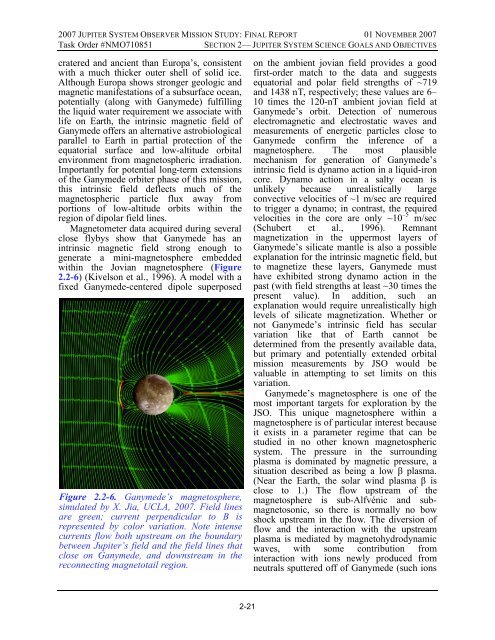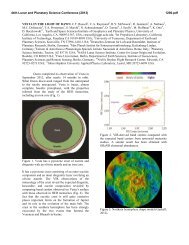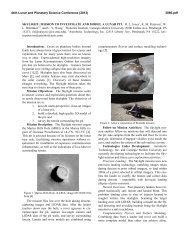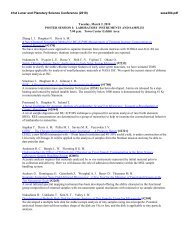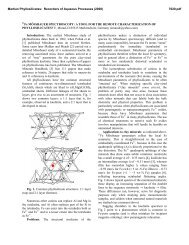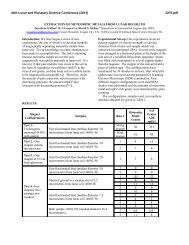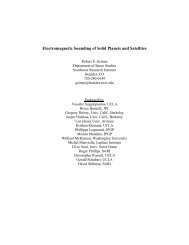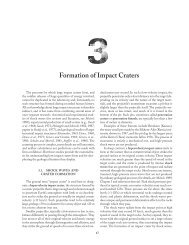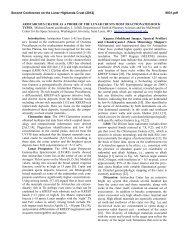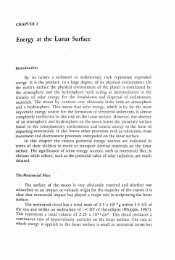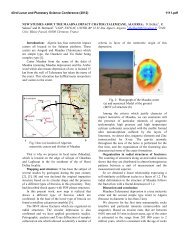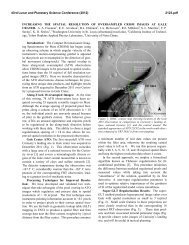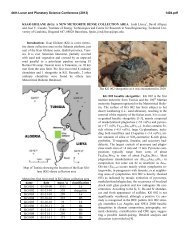Jupiter System Observer Mission Study: Final Report - Lunar and ...
Jupiter System Observer Mission Study: Final Report - Lunar and ...
Jupiter System Observer Mission Study: Final Report - Lunar and ...
Create successful ePaper yourself
Turn your PDF publications into a flip-book with our unique Google optimized e-Paper software.
2007 JUPITER SYSTEM OBSERVER MISSION STUDY: FINAL REPORT 01 NOVEMBER 2007<br />
Task Order #NMO710851 SECTION 2— JUPITER SYSTEM SCIENCE GOALS AND OBJECTIVES<br />
cratered <strong>and</strong> ancient than Europa’s, consistent<br />
with a much thicker outer shell of solid ice.<br />
Although Europa shows stronger geologic <strong>and</strong><br />
magnetic manifestations of a subsurface ocean,<br />
potentially (along with Ganymede) fulfilling<br />
the liquid water requirement we associate with<br />
life on Earth, the intrinsic magnetic field of<br />
Ganymede offers an alternative astrobiological<br />
parallel to Earth in partial protection of the<br />
equatorial surface <strong>and</strong> low-altitude orbital<br />
environment from magnetospheric irradiation.<br />
Importantly for potential long-term extensions<br />
of the Ganymede orbiter phase of this mission,<br />
this intrinsic field deflects much of the<br />
magnetospheric particle flux away from<br />
portions of low-altitude orbits within the<br />
region of dipolar field lines.<br />
Magnetometer data acquired during several<br />
close flybys show that Ganymede has an<br />
intrinsic magnetic field strong enough to<br />
generate a mini-magnetosphere embedded<br />
within the Jovian magnetosphere (Figure<br />
2.2-6) (Kivelson et al., 1996). A model with a<br />
fixed Ganymede-centered dipole superposed<br />
Figure 2.2-6. Ganymede’s magnetosphere,<br />
simulated by X. Jia, UCLA, 2007. Field lines<br />
are green; current perpendicular to B is<br />
represented by color variation. Note intense<br />
currents flow both upstream on the boundary<br />
between <strong>Jupiter</strong>’s field <strong>and</strong> the field lines that<br />
close on Ganymede, <strong>and</strong> downstream in the<br />
reconnecting magnetotail region.<br />
2-21<br />
on the ambient jovian field provides a good<br />
first-order match to the data <strong>and</strong> suggests<br />
equatorial <strong>and</strong> polar field strengths of ~719<br />
<strong>and</strong> 1438 nT, respectively; these values are 6–<br />
10 times the 120-nT ambient jovian field at<br />
Ganymede’s orbit. Detection of numerous<br />
electromagnetic <strong>and</strong> electrostatic waves <strong>and</strong><br />
measurements of energetic particles close to<br />
Ganymede confirm the inference of a<br />
magnetosphere. The most plausible<br />
mechanism for generation of Ganymede’s<br />
intrinsic field is dynamo action in a liquid-iron<br />
core. Dynamo action in a salty ocean is<br />
unlikely because unrealistically large<br />
convective velocities of ~1 m/sec are required<br />
to trigger a dynamo; in contrast, the required<br />
velocities in the core are only ~10 –5 m/sec<br />
(Schubert et al., 1996). Remnant<br />
magnetization in the uppermost layers of<br />
Ganymede’s silicate mantle is also a possible<br />
explanation for the intrinsic magnetic field, but<br />
to magnetize these layers, Ganymede must<br />
have exhibited strong dynamo action in the<br />
past (with field strengths at least ~30 times the<br />
present value). In addition, such an<br />
explanation would require unrealistically high<br />
levels of silicate magnetization. Whether or<br />
not Ganymede’s intrinsic field has secular<br />
variation like that of Earth cannot be<br />
determined from the presently available data,<br />
but primary <strong>and</strong> potentially extended orbital<br />
mission measurements by JSO would be<br />
valuable in attempting to set limits on this<br />
variation.<br />
Ganymede’s magnetosphere is one of the<br />
most important targets for exploration by the<br />
JSO. This unique magnetosphere within a<br />
magnetosphere is of particular interest because<br />
it exists in a parameter regime that can be<br />
studied in no other known magnetospheric<br />
system. The pressure in the surrounding<br />
plasma is dominated by magnetic pressure, a<br />
situation described as being a low plasma.<br />
(Near the Earth, the solar wind plasma is<br />
close to 1.) The flow upstream of the<br />
magnetosphere is sub-Alfvénic <strong>and</strong> submagnetosonic,<br />
so there is normally no bow<br />
shock upstream in the flow. The diversion of<br />
flow <strong>and</strong> the interaction with the upstream<br />
plasma is mediated by magnetohydrodynamic<br />
waves, with some contribution from<br />
interaction with ions newly produced from<br />
neutrals sputtered off of Ganymede (such ions


